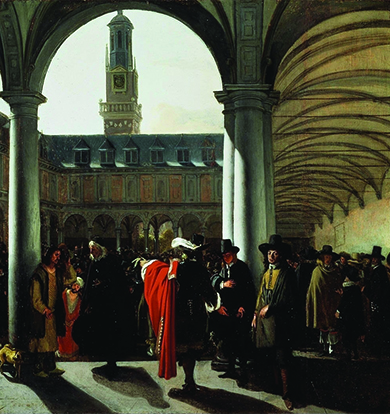| << Chapter < Page | Chapter >> Page > |
To see how cartographers throughout history documented the exploration of the Atlantic World, browse the hundreds of digitized historical maps that make up the collection American Shores: Maps of the Middle Atlantic Region to 1850 at the New York Public Library.
Dutch entrance into the Atlantic World is part of the larger story of religious and imperial conflict in the early modern era. In the 1500s, Calvinism, one of the major Protestant reform movements, had found adherents in the northern provinces of the Spanish Netherlands. During the sixteenth century, these provinces began a long struggle to achieve independence from Catholic Spain. Established in 1581 but not recognized as independent by Spain until 1648, the Dutch Republic, or Holland, quickly made itself a powerful force in the race for Atlantic colonies and wealth. The Dutch distinguished themselves as commercial leaders in the seventeenth century ( [link] ), and their mode of colonization relied on powerful corporations: the Dutch East India Company, chartered in 1602 to trade in Asia, and the Dutch West India Company, established in 1621 to colonize and trade in the Americas.

While employed by the Dutch East India Company in 1609, the English sea captain Henry Hudson explored New York Harbor and the river that now bears his name. Like many explorers of the time, Hudson was actually seeking a northwest passage to Asia and its wealth, but the ample furs harvested from the region he explored, especially the coveted beaver pelts, provided a reason to claim it for the Netherlands. The Dutch named their colony New Netherlands, and it served as a fur-trading outpost for the expanding and powerful Dutch West India Company. With headquarters in New Amsterdam on the island of Manhattan, the Dutch set up several regional trading posts, including one at Fort Orange—named for the royal Dutch House of Orange-Nassau—in present-day Albany. (The color orange remains significant to the Dutch, having become particularly associated with William of Orange, Protestantism, and the Glorious Revolution of 1688.) A brisk trade in furs with local Algonquian and Iroquois peoples brought the Dutch and native peoples together in a commercial network that extended throughout the Hudson River Valley and beyond.
The Dutch West India Company in turn established colonies on Aruba, Bonaire, and Curaçao, St. Martin, St. Eustatius, and Saba. With their outposts in New Netherlands and the Caribbean, the Dutch had established themselves in the seventeenth century as a commercially powerful rival to Spain. Amsterdam became a trade hub for all the Atlantic World.
By the beginning of the seventeenth century, Spain’s rivals—England, France, and the Dutch Republic—had each established an Atlantic presence, with greater or lesser success, in the race for imperial power. None of the new colonies, all in the eastern part of North America, could match the Spanish possessions for gold and silver resources. Nonetheless, their presence in the New World helped these nations establish claims that they hoped could halt the runaway growth of Spain’s Catholic empire. English colonists in Virginia suffered greatly, expecting riches to fall into their hands and finding reality a harsh blow. However, the colony at Jamestown survived, and the output of England’s islands in the West Indies soon grew to be an important source of income for the country. New France and New Netherlands were modest colonial holdings in the northeast of the continent, but these colonies’ thriving fur trade with native peoples, and their alliances with those peoples, helped to create the foundation for later shifts in the global balance of power.

Notification Switch
Would you like to follow the 'U.s. history' conversation and receive update notifications?